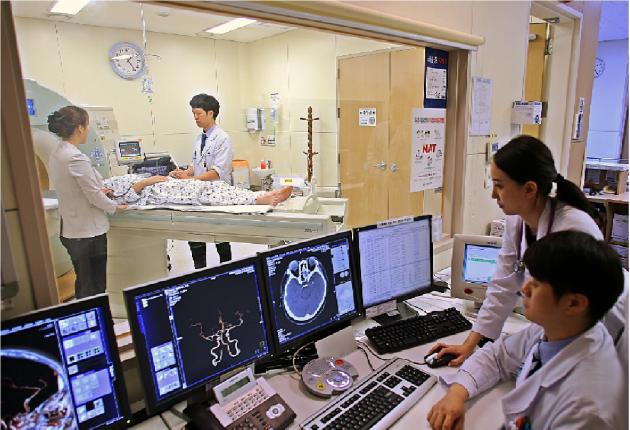Asan Medical Center (AMC) has drastically shortened the time required for acute stroke treatment since it operated an emergency medical care system, the hospital said Wednesday.
In about 80 percent of strokes, the number one cause of death in a single disease is ischemic strokes (cerebral infarction) that block blood vessels. It is important to puncture the clogged blood vessels as quickly as possible, but most patients do not know or observe pre frontal stroke symptoms, which take them more than three hours to arrive at the hospital.
Since May 2016, the AMC서울아산병원 stroke center has run a multi-disciplinary team for strokes, which involves neurology, emergency medicine, radiology, and diagnostic medicine. The team created a patient-tailored emergency care system to tailor the conditions of patients, allowing immediate treatment upon their arrival at the hospital.
About 198 patients were transported to the emergency room of AMC between 2014 and April 2016 and 47 patients were transferred between May and August after the emergency care system was established. The time to receive thrombolytic therapy after the arrival of the emergency room shortened from an average of 46 minutes to 20.5 minutes, and the time required for Thrombectomy significantly decreased from 156 minutes to 86.5 minutes.
Thrombolytic therapy is a method of administering a thrombolytic agent to remove a thrombus directly from the blood vessel. Thrombectomy is used when it’s difficult to deliver the thrombolytic agent or when the clotted blood vessel isn't sufficiently punctured after the administration of the thrombolytic agent.
The time to administrate thrombolytic therapy is the key indicator of acute stroke treatment because recognizing the symptoms, arriving at the hospital and the time of the thrombolytic agent determine the success or failure of the stroke treatment.

Many hospitals in the world are working to shorten the time for thrombolytic therapy after arrival at the hospital. A hospital in Helsinki is the first to establish an acute stroke treatment system through collaboration with emergency medical personnel and has a record of 20 minutes of thrombolytic agent administration time.
The AMC Stroke Center in Seoul has regularly educated 119 paramedics to select patients suspected of having a stroke, and to contact the hotline before transfer and set up an interdisciplinary team dedicated to strokes to dramatically shorten inspection and treatment time. In Korea, the mean thrombolytic agent administration time (median) is 46 minutes after arrival at the hospital.
According to a paper published in the International Journal of Stroke, the rate of patients who were able to receive thrombolysis after rapid treatment increased from about 9.8 percent to 15.8 percent, and the incidence of cerebral hemorrhage, a complication of surgery, decreased from 12.6 percent to 2.1 percent.
"If the brain blood vessels are blocked, 1.9 million brain cells per minute will die. Once damaged brain cells do not survive, blood vessels need to be open quickly,” said Professor Chun Sang-beom전상범 of the Neurology Department of AMC. “However, because time was wasted before they reached the emergency room, it is important that patients who arrive at the hospital are treated quickly.”
"If you have any symptoms of stroke such as becoming speechless, lose strength in an arm or leg, or blacking out, you should seek the nearest hospital that can help stroke as quickly as possible,” said Kim Jong-sung김종성, head of AMC Stroke Center.

